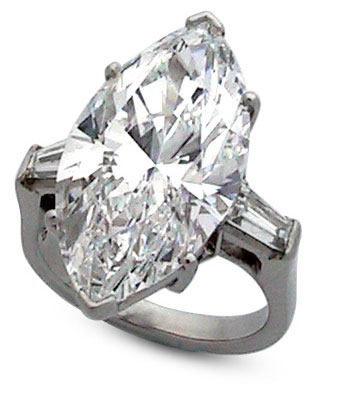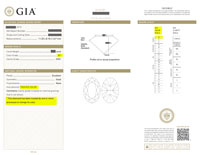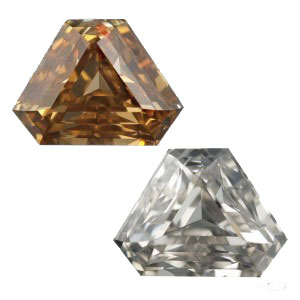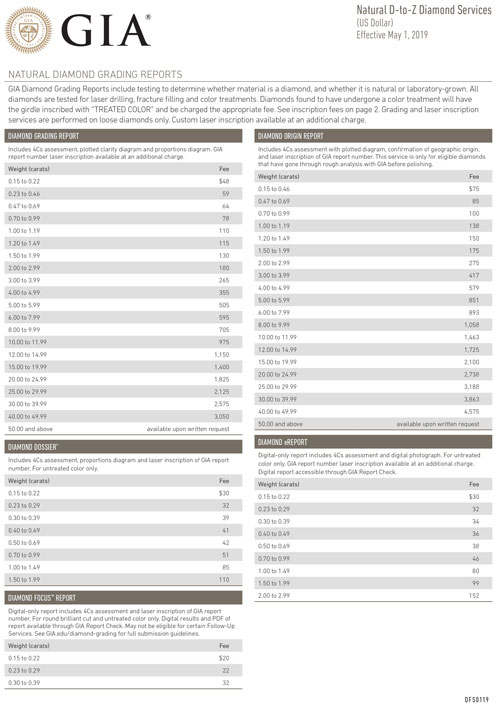GIA report: What's left out

You're about to insure a "GIA-certified" diamond. You have the GIA lab report in hand, so you think it's a safe bet. This report is a reliable description of the gem's quality.
But what does that lab report actually say? And what doesn't it say?
One insurer received a submission recently for coverage of a diamond ring. The GIA "Diamond Grading Report," which is what the insurer received, included an assessment of the 4 Cs, a plotted clarity diagram, and a proportions diagram. The report gave the diamond a D grade for color. D is the highest GIA grade for a colorless diamond, so this should be a gem of high quality.
But . . .
But that "D" was followed by an asterisk. The asterisk explanation, in fine print following all the other grading information, said: "This diamond has been treated by one or more processes to change its color."
This is important information, because a diamond that has been color-treated is worth considerably less than one of the same grade that is untreated.
What's left out
The lab report disclosed treatment but stopped short of stating just what treatment(s) had been used. The type of treatment is important to insurers because, in the event of a loss, a color-treated diamond should be replaced with a diamond that received the same treatment.
One of the most common color treatments is HPHT—high pressure and high temperature. HPHT is a versatile process, used to turn unattractive stones into salable gems for jewelry. HPHT treatment can de-colorize yellowish, off-color diamonds, as shown in the picture at right. It can also transform diamonds of dull, unappealing colors into radiant blues, greens, yellows, and even reds. HPHT is even used to produce lab-grown diamonds.
In all these uses disclosure is essential, and it is required by the FTC Guidelines. One has to ask if this report is in compliance. We'll have a look at the newest FTC Guidelines in a future issue.
Treated gems have a lower value than untreated gems of the same quality, and lab-made stones have a lower value than mined stones of the same quality. The consumer and the insurer are entitled to this information.
A retailer may avoid discussing gem treatments, which are often called enhancements. An "enhanced" gem sounds better than an unenhanced gem, and the buyer or adjuster may not ask questions. The appraisal may fall short, because detection of some gem treatments, and of lab-made stones, often requires technology that is beyond the means of the average appraiser.
We count on GIA, a reputable grading lab with extensive resources and up-to-date expertise, to provide this detailed information.
Why doesn't the Diamond Grading Report state the treatment used?
Because GIA charges extra for that.
To learn the method of a color treatment referenced in a Diamond Grading Report, the customer must purchase a "Diamond Color Treatment Letter" for an additional $85. GIA considers this an "Add-On Service."
Obtaining this Letter does not require re-submitting the stone for additional examination. That means GIA has already determined the method of treatment, it just charges an extra fee to divulge it.
Reading all the docs
It's worthwhile for insurers to read appraisals, lab reports, and sales receipts for any "fine print," unusual terms, or disconnects that may lead to overpayments in the future.
In the case above, the appraisal reflected quality descriptions found on the lab report, but the appraised valuation -- and the coverage requested -- were double the purchase price. Such appraisal inflation is, unfortunately, very common.
Did the appraiser value the ring as though the diamond were untreated, even though he wrote on the appraisal that it was treated? Did the insured believe it was to his advantage to have an inflated valuation? Did the insured understand what a color treatment was, and what effect it had on the gem's value? Was it simply an attempt at fraud?
FYI: GIA, a highly respected lab for diamond grading, offers a number of lab reports, Add-On Services, and Follow-up Services. As technology advances, competition increases and marketing strategies shift, it is increasingly important for jewelry insurers to read all the docs, including lab reports.
FOR AGENTS & UNDERWRITERS
There is a huge value difference between a treated diamond and an untreated one.
Do not assume a diamond is untreated simply because a treatment isn't mentioned on the appraisal. The appraisal should disclose any treatments, or it should specifically state that the gem is untreated.
Detection of treatments can require testing with instruments beyond what would be found in the average jeweler's lab. It's very possible that HPHT-treated diamonds could pass as natural in the marketplace, with consumers and even retailers being fooled and overcharged.
The best appraisal includes the JISO 78/79 appraisal form and is written by a qualified gemologist (GG, FGA+, or equivalent), preferably one who has additional insurance appraisal training. One course offering such additional training is the Certified Insurance Appraiser™ (CIA) course of the Jewelry Insurance Appraisal Institute.
High-value diamond should always have a lab report from a reliable lab, such as GIA. Some gem treatments are difficult to detect and require equipment that only major gem-grading labs can afford.
FOR ADJUSTERS
If the appraisal was not written on JISO 78/79, use JISO 18 to verify that all necessary information was given on the appraisal.
Compare valuation with the sales receipt. If there is a huge discrepancy, the purchase price is more likely to reflect true market value.
Check the appraisal for words like treatment, enhancement, process, HPHT, or irradiation. All these terms denote treatments, which lower the value of the gem compared with an untreated stone.
Pay close attention to the use of the word "natural." While both mined and lab-grown diamonds are natural, the word "natural" is often used (as in the GIA report shown above) to denote a mined diamond. Also, a mined stone subjected to color treatment is natural in origin but not natural in color.
In settling claims for high-value diamonds, be wary if
- any treatments are mentioned;
- the appraisal does not list treatments, yet does not state that the gem is untreated;
- the only appraisal available is one supplied by the seller (because it is in the seller's interest to exaggerate qualities or withhold crucial information);
- there is no gem report from a reliable lab independent of the seller
Check the appraisal and other documents for brand names. Brands are often associated with quality, treatments, or lab-created gems.
©2000-2025, JCRS Inland Marine Solutions, Inc. All Rights Reserved. www.jcrs.com




